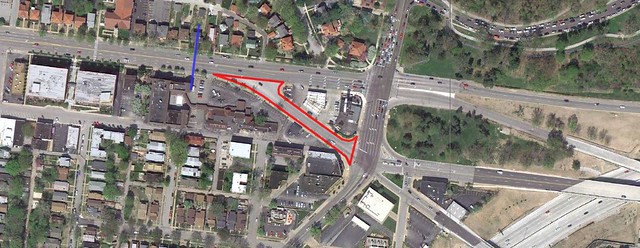
{city/county border in blue, portion of Clayton Avenue shown in red}
The City of St. Louis and the municipalities of St. Louis County need development. We need to rehabilitate our existing infrastructure, preserve our historic buildings and return them to use. Using incentives to do so is standard practice, and in many cases necessary to encourage development. So, the announcement that the Cheshire Inn complex, straddling the City of St. Louis-Richmond Heights line has a new owner and redevelopment plan came as good news. The usual suspects of incentives are all there, property tax abatement and sales tax benefits from Richmond Heights, a decade of tax abatement from the City of St. Louis and the city vacating Clayton Avenue from Clayton Road to Skinker.
The City of St. Louis has vacated too many public city streets, and continues to do so seemingly at the mere request of any business or institution. This trend is damaging and practically impossible to reverse once implemented. There should be a high standard of information and evaluation required before permanently vacating a city street. Has there been a traffic analysis of the impact of such a closure? On what merits will the proposal be evaluated? How are the potential benefits and negative effects considered and weighed?
In this case, according the Post-Dispatch, the additional land given to the Cheshire development would be used for surface parking. And this is needed because the new owner envisions multiple restaurants, a coffee house and market on the property. Much depends on the execution of this vision, but adding amenities to the Hi-Pointe/Demun neighborhoods would be a good thing.
What purpose does this one block currently serve? Clayton Avenue provides access to the BP/Amoco station and the Cheshire Inn. Access to both would remain, and presumably be improved, at least from the west, with the closure of Clayton Avenue. This stretch also provides direct access to and from the east via Clatyon and Oakland Avenues. If closed, all traffic wishing to access Clayton Road would be required to make a short jog on Skinker Boulevard. This would add some amount of traffic to an already busy intersection.
The cluster of roads converging at the Hi-Pointe Theatre and number of stoplights directing traffic are confusing. Closing Clayton Avenue only to the west will do very little to improve this confusion. In the end, the closure will put more traffic through an already congested intersection, eliminate a direct route to Clayton Road and Richmond Heights for residents of the City's Dogtown neighborhood and those using Oakland Avenue to access Forest Park Community College, the Highlands or Forest Park and provide parking for a business owner who will bring amenities to the neighborhood, revitalize an historic hotel and receive significant tax benefits in the process.
Anyone willing to bet whether or not Clayton Avenue will be a parking lot in the near future?

{a view of Clayton Avenue looking west from Skinker Boulevard}

{a view of Clayton Avenue looking east from Clayton Road}


